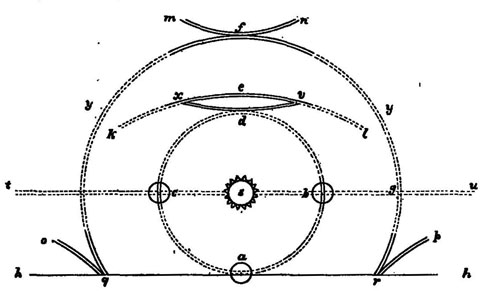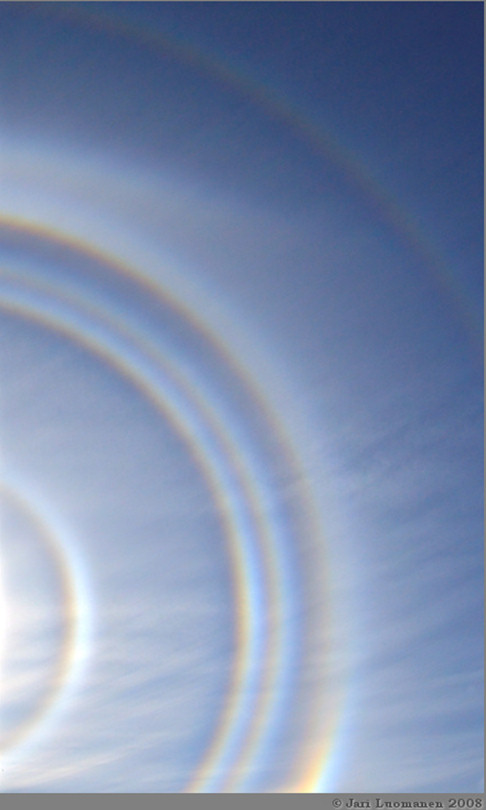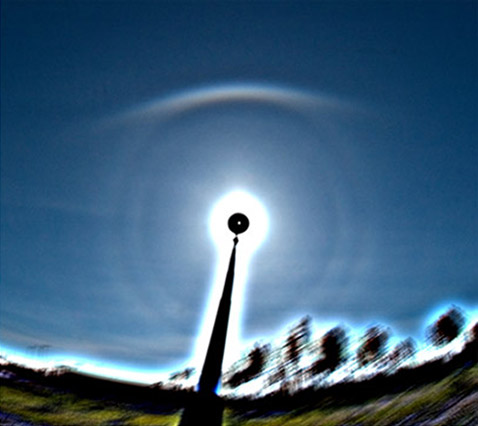A major pyramidal crystal display was observed on 5 June in Southern Finland. The center of the action was located in Tampere, where the photo above was taken by Jari Luomanen.
Several people noticed the display and photographic documentation is extensive. For more photos, browse the messages of our mailing list ( 1 ), starting from 05.06.2008.
2008. június 9., hétfő
2008. június 4., szerda
Reign of Pyramids
Photograph above by Marko Riikonen on 1st June 2008.
A noteworthy streak of pyramid crystal halos in Europe started with a display on 27th May in Stavanger, Norway, where two Hungarian observers took photos in the evening: András Uhrin ( 1 - 2 ) and Éva Bora ( 3 - 4 ). Their photos show 9° halo, 18° halo, 18° plate arcs and a hint of an upper 23° plate arc.
Next day, on 28th May, Jarmo Moilanen captured a subhelic arc in Oulu, Finland ( 5 ). Meantime in Kokkola, Finland, the odd-radius halo streak was marginally kept alive by a short-lived appearence of 9° halo ( 6 ).
On 30th May in Turku, Finland, observers were alert in the afternoon. The 23° upper plate arc and halo rings with radii of 9°, 18°, 20° and 23° were photographed by Joni Tahkoniemi ( 7 ) and Pertti Havia ( 8 ). A one day gap between pyramid crystal displays occured on 31st May, when as consolation a faint display with a long parhelic circle was seen in Riihimäki ( 9 ).
The morning of 1st June kept observers busy in Southern Finland. At around nine a.m. a very classy 23° upper plate arc was observed by Reima Eresmaa in Lammi, Jukka Ruoskanen in Riihimäki ( 10 ) and Marko Riikonen in Vantaa ( 11 ). Faint 18° plate arcs were in the sky as well. Later on photographs revealed also 20° and 23° halos. Marko was most alert, and was able to catch the maximum of the display. 9° and 35° halos and the pyramid helic arc appear in his photos. The pyramid helic arc was to be expected to show up because of the quality of the 23° upper plate arc. For further information see Marko's comments below the photos in his gallery.
Few moments after the maximum stage in Lammi, Riihimäki and Vantaa the halos striked Juva, where Jari Piikki photographed a magnificient set of pyramid crystal halos ( 12 ). Most distict features in Jari's photos are strong 20° and 35° halos.
Next morning, on 2nd June, Menno van der Haven photographed a pyramid crystal halo in Curteni, Romania ( 13 ). The display is very similar to Jari Piikki's display the day before, except that the 23° upper plate arc is a bit stronger and the 20° halo is weaker. 35° halo is of the same caliber.
2008. június 2., hétfő
What's missing from Parry's drawing?

"r p, q o, arches of large circles, very strongly prismatic, which could
only be traced to p and o; but on that part of the horizontal circle
t u, which was directly opposite to the sun, there appeared a confused
white light, which had occasionally the appearance of being caused
by the intersection of large arches coinciding with a prolongation of
r p, and q o."
Possibly there were traces of the white arcs from column crystals, which caused the occasional impression of anthelion being caused by the extension of infralateral arcs (r p, q o). At least later these faint white arcs became so clear as to make further note of them:
"At 90° from the sun, on each side of it, and at an altitude of
30° to 50°, there now appeared also a very faint arch of white light,
which sometimes seemed to form a part of the circles q o, r p; and
sometimes we thought they turned the opposite way."
Subhelic arc coincides with 46° infralateral arc at the drawing's sun elevation. Most likely, however, there were other arcs as well, Wegener and helic arc, which added to the confusion. And finally, also 46° Parry arcs were observed:
"In the outer large circle, we now observed two opposite and
corresponding spotsonding spots y y, more strongly prismatic
than the rest..."
The halos were seen in Canada's Melville Island on 9 April 1820. The display was long lasting; from 1 at least until 6 pm. Observers paid also attention to sun elevation depended changes in the halos by noting the growing distance between upper tanget arc and Parry arc and the shape change in tangent arc. The excerpts of the observational account are taken from Hasting's "A general theory of halos" ( 1 )
Feliratkozás:
Bejegyzések (Atom)

